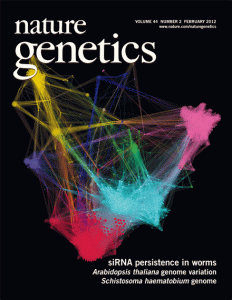A good summer project can be a great way for father and son to bond. Google the phrase “father-son summer project” and you’ll find examples of fathers and sons doing things together such as planting a garden, restoring an old truck or building a computer.

But when the father is Patrick Sullivan, MD, a prolific researcher and faculty group leader in UNC’s Department of Genetics, and the son is Brendan Bulik-Sullivan, a senior math major at the University of California, Berkeley, the summer project is likely to be more academic in nature.
In their case, what Sullivan calls “our summer project” ended up gracing the cover of a major scientific journal: the February 2012 issue of Nature Genetics.
Sullivan says the project grew from his desire to find a way to visualize what he calls the “authorship network of genome-wide association studies.” It was inspired in part, he said, by the Erdős number, a concept which describes the “collaborative distance” between a person and mathematician Paul Erdős, as measured by authorship of mathematical papers.
The idea of the Erdős number is well-known in scientific circles as a tongue-in-cheek measurement of mathematical prominence. The same principle has been proposed for other eminent persons in other fields.
Working together, Sullivan and his son created a coauthorship network graph that depicts the connections among more than 21,000 authorships (by 8,718 individuals) of 604 genome-wide association studies that were published from 2005 through 2008. The color-coded graph forms a shape that resembles the human heart, with each color representing particular concentrations of study.
In the photo to the right, for example, studies of type 2 diabetes and cancer are represented in gold. Crohn’s and Alzheimer’s studies are represented in crimson. (See Supplementary Figure S4 at http://www.nature.com/ng/journal/v44/n2/extref/ng.1052-S1.pdf.)
Individual researchers may find it fun to place a “you are here” pin for themselves on the graph, Sullivan said, but the graph also serves a more serious scientific purpose.
“Scientists know that biological systems have complex parts lists. But, many methods in molecular medicine tackle these systems one molecule at a time. There’s a rising theme in medicine about how study to systems and networks holistically. Figuring out how to ‘see’ such networks was the point of the summer project. The math was pretty hideous, but Brendan got on top of it fast, and explained it cogently,” Sullivan said.